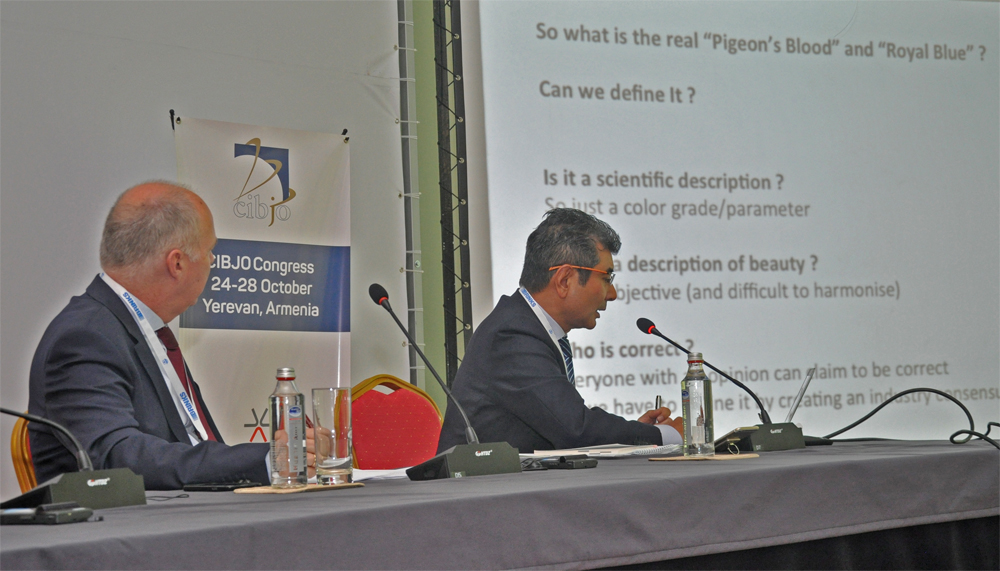Pigeon’s Blood and Royal Blue colours focus of lab report consistency debate

Hanco Zwaan (left), President of CIBJO’s Gemological Commission, and Nilam Alawdeen, President of CIBJO’s Colored Stone Commission, during the special session held to discuss consistency in laboratory reports.
OCTOBER 26, 2016
A special session on the inconsistencies of coloured gemstone laboratory reports, during the first day of the 2016 CIBJO Congress, focused on the issue of Pigeon’s Blood ruby and Royal Blue sapphire colours. The session was chaired by Hanco Zwaan, President of CIBJO’s Gemmological Commission.
Nilam Alawdeen, Chairman of CIBJO’s Coloured Gemstone Commission, provided the trade’s perspective, saying that consumers believe that Pigeon’s Blood ruby and Royal Blue sapphire are industry standards or a quality grade when they are not. There have been many such reports in the last three years, mostly in Asia. But consumers are confused and there have been a lot of returns of reports to lab, because each lab has its own standards, he said.
“Should we leave this situation as it is since have a free market with consumers free to decide which description is accurate, or should the industry set guidelines and thus win over the trust of consumers?” he asked.
He gave some of the history of the colours, saying Pigeon’s Blood red probably started in the Mogok area of Myanmar (Burma) more than 100 years ago. Meanwhile, another dealer probably invented the term Royal Blue which sounded better than his competitors’ simple blue colour, but there is no scientific justification for these terms, he explained.
In the last 25 years, labs have increasingly used these terms to describe the colour and not the quality of the stone. “Is it a description of beauty? It is very subjective to do so and everyone can be right. It also depends in which light the stone is seen and in which country.” He said that a search of Pantone’s colour charts turned up several types of Royal Blue, but no Pigeon’s Red. He asked if an industry consensus should be created.
Mr. Alawdeen added that manmade colour borderlines create an un-natural jump in prices for stones which do not receive the required title/name in the grading report. He concluded by stressing that he was not attacking the grading labs who do an excellent job in driving sales.
For the sake of maintaining consumer confidence in the integrity of reports, there should be an attempt to harmonize and to separate the scientific from the subjective colour descriptions in reports. Labs should say that the colour is clearly their opinion and this should ideally be noted on a separate page, he stated.
Dr. Michael Krzemnicki, Director, Swiss Gemmological Institute SSEF, spoke about harmonization between the SSEF and Gubelin Gemlab which has been in effect for the past year.
He said that the lab had been asked to give its opinion by the trade and to mention them on reports. He showed a report from the 19th Century of Pigeon’s Blood red of a ruby from Mogok.
A lab must create its own internal standards and that then needs to be harmonized, he explained. The GIA, for example, has created a standard for fancy colour diamonds. He also spoke about the factors involved in setting criteria for setting a colour, and called for international harmonization.
Shane McClure: Global Director of Coloured Stone Services, GIA, spoke about country of origin reports and that they could lead to differing opinions. Some rubies will receive better grades because they are from Burma, but they actually might be inferior.
“Blue sapphire is the most difficult situation we face,” he commented. “Conflicting reports from different labs probably happens most regarding blue sapphires.”
Among the problems he outlined for differing reports were the big difference in the capability of labs and the equipment they can use, as well as the level of experience of staff and availability or otherwise of reference materials which he said are vital.
“The properties and characteristics of stones especially blue sapphires can overlap sometimes so much so that it’s difficult to determine the origin. Different types of deposits have different properties. If a stone is clean, then it is even more difficult to assess and also if it is heat treated. High temperature is not usually a problem, but stones that have undergone low temperature treatment can be more difficult to determine although it doesn’t usually alter internal features or properties significantly.”
Among the solutions to the problems raised regarding the colour issues was not using provenance “but that is not going to happen”. He said GIA is continuously carrying out research. He also proposed that criteria should be shared with labs comparing master stones. The GIA has done this twice in Bangkok with several local labs, he said.
He noted that colour designations are not popular in the United States and the GIA takes a lot of criticism for providing them on its reports. Clients say it is only a sales tool and labs should not be involved in providing it, he concluded.
Finally, Pornsawat Wathanakul, Director of the Gem and Jewelry Institute of Thailand (GIT), said the lab has developed a colour communication system since 1999. It has carried out a comprehensive research project on coloured stones with surveys, consultations with experts, questionnaires and other means.
She spoke of the difficulty in obtaining accurate colour mastersets for ruby and royal blue sapphires, but said the GIT eventually succeeded in doing so. And this year has created a master set for Cornflower blue, she said, adding that GIT reports do not include origin information.
